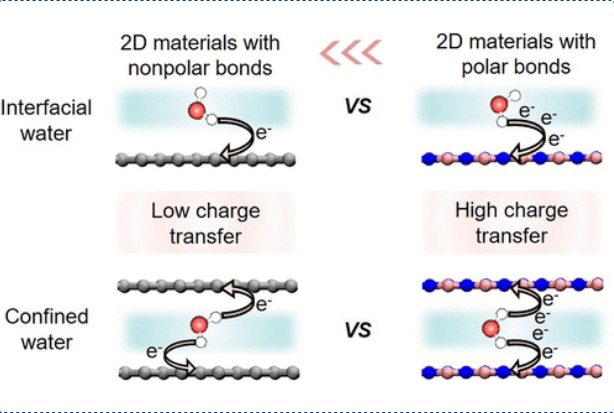Yuwei Cao,Chenchen Zhou,Wanqi Zhou,Chun Shen,Bao Jin,
Tianbao Ma,Hu Qiu*,andWanlin Guo*
J. Am. Chem. Soc.(IF:14.4),Published April 14, 2025
Abstract
Charge transfer at solid–liquid interfaces is pivotal in biochemical processes, catalysis, and electrochemical devices. However, understanding the charge transfer mechanism at the nanoscale solid–liquid interface remains highly challenging. Here, we conduct ab initio molecular dynamics simulations to investigate interfacial charge transfer between water and the two most common two-dimensional materials: graphene with nonpolar C–C bonds and hexagonal boron nitride (hBN) with polar B–N bonds. It is counterintuitive to find that the charge transfer between water and hBN is approximately 1 order of magnitude higher than that between water and graphene despite the fact that graphene is semiconducting and hBN is insulating. Our further analyses attribute this phenomenon to a higher tendency of water molecules to point a hydrogen atom toward the hBN surface compared to the graphene surface, although they have similar crystallographic structures. This single hydrogen-down water configuration on the hBN surface prompts electron delocalization from hBN and facilitates electron migration to water. Moreover, the polar B–N bonds in hBN result in a strong orbital overlap between nitrogen atoms and hydrogen atoms of water. A similar charge transfer enhancement is also observed between water and two-dimensional gallium nitride (GaN) and aluminum nitride (AlN), which also own polar bonds, and a positive correlation between the charge transfer and the bond polarity is demonstrated. Further simulations indicate that the friction coefficient of water on graphene and hBN surfaces positively correlates with the amount of charge transfer. These findings suggest that materials with polar bonds like hBN can serve as promising materials for biochemical sensors and energy conversion devices.

DOI:https://doi.org/10.1021/jacs.5c00480
--校内链接--
--校外链接--

微信公众号